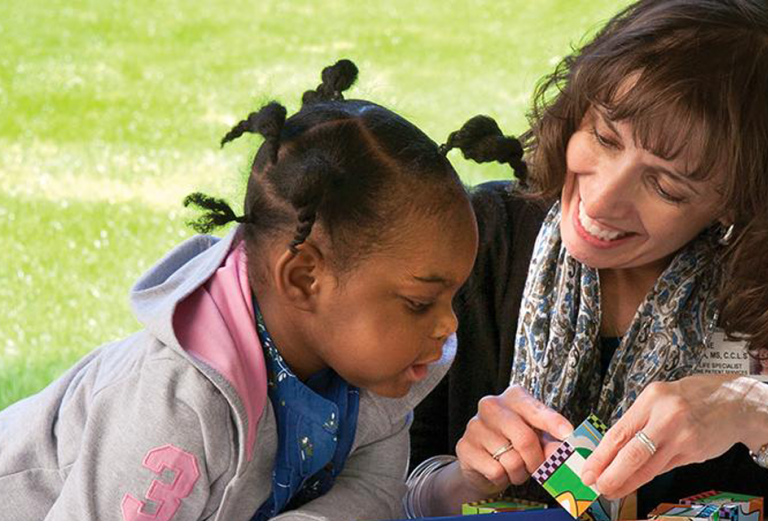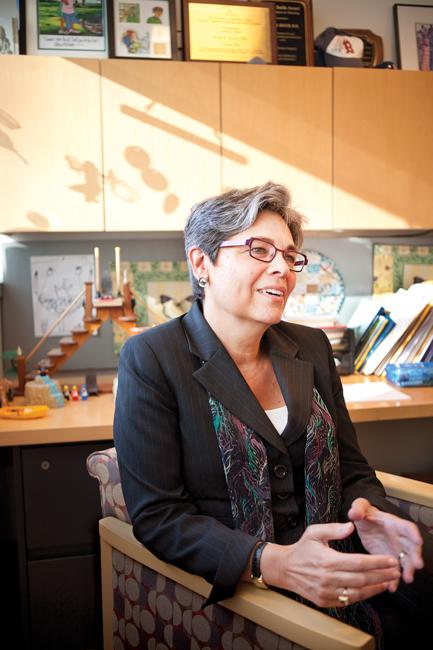
Woman with a child holding a block
For children whose lives are interrupted by illness, the power that play brings to healing and wholeness cannot be overestimated. Be they toddlers or teens, youngsters crave opportunities to express their thoughts, their creativity, and their emotions. Much of that self-expression comes through play. Increasingly, medical professionals are integrating play into the daily regimens of young patients in hospitals. From books to board games to bicycles, the forms of play available to pediatric patients are as varied as the ailments that bring them to the hospital. But the need for play, and the outlet it provides, remains constant.
Star Dust
Suzanne Graca holds a wand filled with stars. Smooth and cool to the touch, the small stick shimmers when held in the light. When she waves it, the stars tumble, revealing sparkles of red, blue, and gold. Graca hopes their movement will mesmerize her young patient. If this works, the test, treatment, procedure, or examination that brought the tiny patient to the big hospital will seem less frightening. This is the magic of the child life specialist.
Graca, who is Child Life Education Coordinator at Boston Children’s Hospital, describes her work as helping children be children by normalizing the hospital environment. That sense of normal is found through play. “It’s amazing to see how play can transform children who are enduring painful and sad situations,” Graca says. “Play is their world. It’s how they communicate, how they comprehend their environment, so we use play in what we do. It can be truly magical for the patient and family.”
Graca taps into that magic when she seeks to distract pediatric patients who are about to undergo difficult procedures. By calming a child, Graca can sometimes eliminate the need for the young girl or boy to be restrained or anesthetized during a procedure.
The bag of tricks Graca pulls from is stuffed with the ABCDs of distraction, a toolkit of care developed by the interdisciplinary pain committee at Children’s. The mnemonic guide refers to the use of assorted visuals, like the wand filled with stars; breathing exercises; comfort measures; and diversionary talk when helping patients prepare for or deal with pain.
Inducing relaxation by getting a child to blow bubbles, for example, is fun for the child and far more effective than saying “take a deep breath.” Likewise, comfort can be gained from snuggling in a blanket from home rather than one from the hospital. Even a child’s position—lying flat or sitting upright—can influence comfort. Often, Graca will invite the patient to sit on the parent’s lap so that the youngster feels more in control and less anxious.
Graca builds her care plans by drawing on her child-development training, determining the approach and form of play most appropriate to the patient’s developmental stage, while also keeping in mind that “everyone regresses a little when ill.”
Although Graca’s resume includes the title of Instructor of Child Life and Family Studies at Wheelock College, it is the unofficial one of Play Lady that may mean the most to her. “If a child calls me a play lady, that means I’m doing my work,” she says. “Children need more than medicine to get through the difficult experience of being in the hospital. They need the freedom of expression that comes through play.”
Timed Release
Paula Rauch’s desk at MassGeneral Hospital for Children, the pediatric hospital of Massachusetts General Hospital, is guarded by a fortress built of translucent blocks; the office door is flanked by a child-sized doll house. Sunlight glints off the suspended figurines of angels and dancers before lending a glow to silver pillows plumped on a couch. A shelf above her desk serves as a perch for a framed illustration, a reminder of when Rauch, an HMS associate professor of psychiatry at Mass General, served as an ongoing consultant on Arthur, the popular PBS cartoon program.

From her 30 years at Mass General, Rauch knows well the trying experiences that face families who must deal with disease. “A four-year-old, once admitted to the hospital, might not realize that he or she won’t live in the hospital forever,” explains Rauch. “So, while everyone may be nice to them, from a child’s perspective, if you think you can never go home again, it’s like being a prisoner. A child psychiatrist’s role is to help the medical team see things from the child’s viewpoint.”
At Mass General, child psychiatrists and child life specialists share a commitment to supporting the emotional health of their young patients. Child psychiatrists, in particular, work to identify emerging mood or anxiety symptoms as well as emotional symptoms associated with certain medications or disorders.
According to Rauch, young children have a greater chance of coping successfully with worries about disease if medical teams give them the opportunity to express their worries through play. And if a child life specialist, a child psychologist, or a child psychiatrist is allowed to observe that play, to essentially see those worries in action, that professional can then interpret and share the child’s concerns with clinicians and family.
While play can help children comprehend and cope with illness, the precise type of play can vary, says Rauch. Patients under the age of three are most comfortable with their parents. So, when the goal is to support the child as he or she prepares for a procedure or a test, the clinicians may offer parents the tools to engage in supportive play. Children ages three to six have what Rauch calls magical thinking. “Everything happens for a reason and the reason is them.” Make-believe and other forms of expressive play help children in this age group demonstrate their fears about illness.
Children in elementary school organize their thinking around rules. They tend to generalize from their experience, imagining, for example, that everything is as contagious as a common cold. Talking with a child to determine what these misconceptions are is an important step toward helping to alleviate their worries.
The need for independence grows during adolescence, thus adolescents seek to express themselves creatively through art, watching movies, playing videogames, and connecting with friends virtually.
The continuum of development brings challenges to health care professionals who wish to help children cope with hospitalization. Giving children a chance to ask questions about their illness, and respecting their perspectives on their experience, says Rauch, keeps children from being confused and enables them to develop a healthy outlook as they move forward.
Child, Interrupted
Mary Patstone strides through the halls of Spaulding Rehabilitation Hospital and out to its patio and pier that rest along Boston’s Charles River. The river sparkles in the sun as Patstone surveys the equipment and gear she uses to introduce youngsters to cycling, kayaking, rock climbing, and other sporting and recreational activities that are available to patients, despite their physical challenges.

“We’re fortunate to have the pier right here on the campus, so we can get our patients out on the water before they leave the hospital,” says Patstone, who directs the Spaulding Adaptive Sports Center’s Dr. Charles H. Weingarten Adaptive Sports and Recreation Program in Boston, one of three such centers in eastern Massachusetts. That early involvement, she adds, increases the chance a patient will stay active after leaving the hospital.
Program coordinator and physical therapist Bobbi Delaney teamed with the MGH Institute of Health Professions to investigate the physical and psychosocial benefits of the adaptive sports program. Delaney’s findings show that patients who participated in the program reported their athletic ability had improved an average of 65 percent in such physical components as flexibility, strength, endurance, and balance. The results showed a significant increase—to around 85 percent—in such psychosocial measures as confidence, self-esteem, and mood. In addition, 88 percent said they felt more motivated to exercise regularly. Delaney thinks these findings indicate that once individuals learn they can overcome barriers to their participation in physical activity by using adaptive equipment that optimizes their strengths, they are more likely to remain physically active.
“When kids are hospitalized and they can’t play, a feeling of depression can really hit them,” Patstone says. “But if you can get children out and playing again, and feeling normal or as close to normal as they can, the healing process and progress increase.”
As evidence, Patstone recalls Melissa, a young patient who entered the program after suffering a swimming accident that deprived her brain of oxygen, causing neurological damage that required her to relearn everything she had previously been able to do. Once in the program, with access to the outdoors, her recovery seemed to progress more rapidly, says her father. Although still a work in progress, the nine-year-old is back riding a bicycle and attending ballet class. She has even started rock climbing.
When kids feel normal, their parents begin to heal as well, says Patstone. “They can take a breath and go, ‘Wow, she’s laughing, she’s having a good time. She’s a child again.’ That realization really bolsters the healing process.”
The use of adaptive sports as a tool for rehabilitation is burgeoning as awareness grows for universal access, disability advocacy, and veterans’ services. There are 40 adaptive sports agencies in Massachusetts alone, and Patstone helps some of them develop their own programs. Many of the programs, in fact, provide support for Patstone’s former patients as they work to continue to build a healthy life.
Patstone sees this upward trajectory continuing. “I believe the adaptive sports arena will look dramatically different in ten years, as it benefits from more consistent oversight and the development of common goals.”
If true, then more children who face disabilities resulting from accidents or illness can, like Melissa, look forward to enjoying a childhood that is just interrupted, not halted.